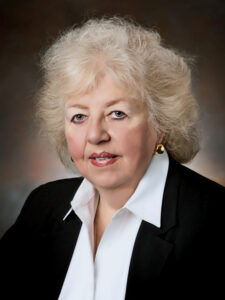
In a male-dominated industry, glass chemistry expert Carol M. Jantzen, PhD, became the first woman president of the American Ceramic Society more than 25 years ago, was responsible for overseeing a major glass plant for two-plus decades, and was a consulting scientist for the Savannah River National Laboratory from 1982 to 2019. Today, she is an affiliate faculty member at the University of South Carolina, Aiken, with nearly 300 academic and professional published works to her credit, having earned a Doctor of Philosophy in material science and engineering from Stony Brook University in New York. She also holds master’s and bachelor’s degrees in geology and an honorary doctorate in recognition of her full body of work, all from Queens College, City of University of New York, and is participating in a post-doctoral fellowship.
Attributing her success to being open-minded, never saying no, and learning from her team members to work collaboratively, Dr. Jantzen has been named a distinguished alumna at each alma mater, a past winner of the U.S Department of Energy Office of Science Distinguished Scientist Award, and the recent recipient of the Donald Orth Lifetime Achievement Award, the highest honor given by the Savannah River National Laboratory for technical excellence and leadership. Her PhD focused on ceramic engineering with a specialty in glass chemistry, and she started out in geology studying molten magma, which is related to glass chemistry. Thus, she credits the combination of her geology and engineering backgrounds for helping her to stand out, providing exceptional support throughout her career, and giving her the self-confidence to attempt and excel in a project that she initially had little knowledge of or perceived as difficult. As a result, Dr. Jantzen says she likes to be challenged and has learned to expect the unexpected.
After she completed her master’s degree in geology, she found there were few job opportunities unless she taught at a university in a geology department. She, therefore, spent about a year at the Pennsylvania State University as a professor, first teaching metallurgy and then switching to geology. When Dr. Jantzen began working in geochemistry in the 1960s, there were a few women, and still are, yet she liked the variety of the work at the glass plant that ran 24 hours a day for seven days a week. In 1976, she entered the nuclear waste field among a handful of women and would, in later years, develop a two-to-three-hour course from her engineering experience at the nuclear plant.
Dr. Jantzen was inspired early in life by her father, a geologist who encouraged her to become a scientist, showed her the value of earning her own living, and later worked alongside her. She fondly recalled when the two of them bought and sold rocks and materials and made educational kits for the American Museum of Natural History and the Hayden Planetarium. He often showed her science articles in Life Magazine and bought her children’s books on astronomy. Nowadays, Dr. Jantzen and her husband, John Pickett, PhD, a chemist, often work on projects together.
In the coming years, Dr. Jantzen plans to continue teaching at the University of South Carolina, Aiken. Her short-term goals are to finish creating dinosaur and crystal exhibits for the public. She also guest teaches upon request at other institutions while trying to significantly increase interest in her longtime profession among all college women who are enrolled in science and engineering. Along with these endeavors, Dr. Jantzen has been a volunteer at the National Academy of Science for 25 years and is chair of the Citizens for Nuclear Technology Awareness. In her spare time, she enjoys rock collecting, raising yellow Labradors, gardening, and sewing.
